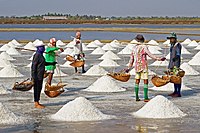
Photo from wikipedia
We investigated metal accumulation in bamboo leaves during three seasons at three urban locations differing in pollution levels. The higher content of Cu, Pb, and Zn in the leaves was… Click to show full abstract
We investigated metal accumulation in bamboo leaves during three seasons at three urban locations differing in pollution levels. The higher content of Cu, Pb, and Zn in the leaves was in correlation with the highest bioavailable content of these elements in the soil at the most polluted location. The content of leaf trace elements was higher in summer and autumn compared to spring. Scanning electron microscopy with energy dispersive X-ray spectroscopy showed that Si accumulation in bamboo leaves was the highest in epidermis and vascular tissue, and was co-localized with trace metals. Analysis of phytoliths showed co-deposition of Al, C, and Si, implying the involvement of Si in metal detoxification. Compared to a common urban tree, linden, bamboo showed better capacity to maintain cellular redox homeostasis under deteriorated environmental conditions. The results suggest that bamboo can be efficiently used for biomonitoring of air and soil metal pollution and remediation in urban areas.
Journal Title: Bulletin of Environmental Contamination and Toxicology
Year Published: 2017
Link to full text (if available)
Share on Social Media: Sign Up to like & get
recommendations!